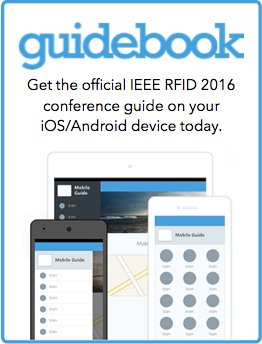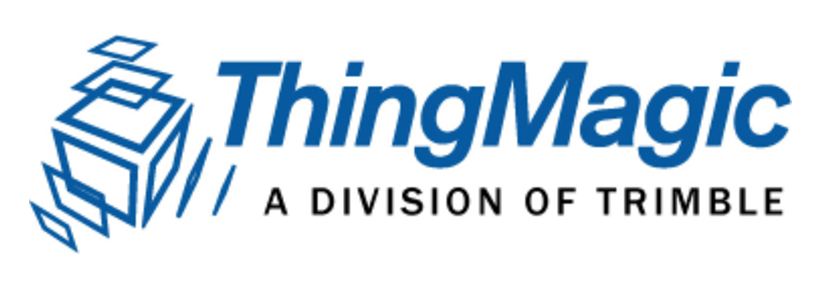Best Paper Award Nominees
Listed in alphabetical order by title. Winners announced on Wednesday’s opening plenary session!
Activity Recognition for Medical Teamwork Based on Passive RFID
Xinyu Li, Dongyang Yao, Xuechao Pan and Jonathan Johannemann (Rutgers University, USA); JaeWon Yang and Rachel Webman (Children’s National Medical Center, USA); Aleksandra Sarcevic (Drexel University, USA); Ivan Marsic (Rutgers University, USA); Randall Burd (Children’s National Medical Center, USA)
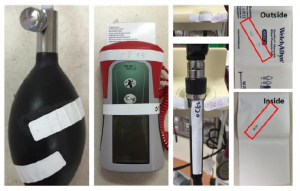 We describe a novel and practical activity recognition system for dynamic and complex medical settings based only on passive RFID technology. Our activity recognition approach is based on the use of objects that are specific for the given activity. First, the object-use status is detected based on RFID data; second, the activities are predicted based on the statuses of different object-use. We tagged 10 objects in a trauma room of an emergency department and recorded RFID data for 10 actual trauma resuscitations. More than 20,000 seconds of data were collected and used for analysis. The system achieved an overall 96% accuracy with a 0.74 F-score for detecting object-use of 10 commonly used medical objects and 95% accuracy with a 0.30 F Score for activity recognition of 11 different medical activities.
We describe a novel and practical activity recognition system for dynamic and complex medical settings based only on passive RFID technology. Our activity recognition approach is based on the use of objects that are specific for the given activity. First, the object-use status is detected based on RFID data; second, the activities are predicted based on the statuses of different object-use. We tagged 10 objects in a trauma room of an emergency department and recorded RFID data for 10 actual trauma resuscitations. More than 20,000 seconds of data were collected and used for analysis. The system achieved an overall 96% accuracy with a 0.74 F-score for detecting object-use of 10 commonly used medical objects and 95% accuracy with a 0.30 F Score for activity recognition of 11 different medical activities.
Application of Low Scattering Antennas to RFID Networks
Shadi Ebrahimi Asl, Mohammad Tayeb Ghasr and Maciej Zawodniok (Missouri University of Science and Technology, USA)
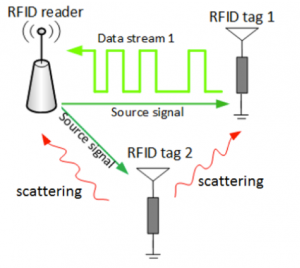 An established backscattering link between an RFID tag and an RFID reader suffers from high interference from all the other RFID tags in the network. This interference results in low read rates in RFID networks. In this paper, we investigate a new state for an RFID tag in which the tag switches to an invisible (i.e. low scattering) state when an ongoing communication between an RFID reader and another target RFID tag is ongoing. We show both by simulation and measurements that by using this method the interference to the backscattering link is minimized and the read rate increases.
An established backscattering link between an RFID tag and an RFID reader suffers from high interference from all the other RFID tags in the network. This interference results in low read rates in RFID networks. In this paper, we investigate a new state for an RFID tag in which the tag switches to an invisible (i.e. low scattering) state when an ongoing communication between an RFID reader and another target RFID tag is ongoing. We show both by simulation and measurements that by using this method the interference to the backscattering link is minimized and the read rate increases.
EM-ID: Tag-less Identification of Electrical Devices via Electromagnetic Emissions
Chouchang Yang (Disney Research, USA); Alanson Sample (Disney Research Pittsburgh, USA)
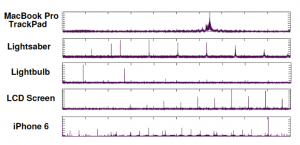 Radio Frequency Identification technology has greatly improved asset management and inventory tracking. However, for many applications RFID tags are considered too expensive compared to the alternative of a printed bar code, which has hampered widespread adoption of RFID technology. To overcome this price barrier, our work leverages the unique electromagnetic emissions generated by nearly all electronic and electromechanical devices as a means to individually identify them. This tag-less method of radio frequency identification leverages previous work showing that it is possible to classify objects by type (i.e. phone vs. TV vs. kitchen appliance, etc.). A core question is whether or not the electromagnetic emissions from a given model of device, is sufficiently unique to robustly distinguish it from its peers. We present a low cost method for extracting the EM-ID from a device along with a new classification and ranking algorithm that is capable of identifying minute differences in the EM signatures. Results show that devices as divers as electronic toys, cellphones and laptops can all be individually identified with an accuracy between 72% and 100% depending on device type. While not all electronics are unique enough for individual detection, we present a probability estimation model that accurately predicts the performance of identifying a given device out of a population of both similar and dissimilar devices. Ultimately, EMID provides a zero cost method of uniquely identifying, potentially billions of electronic devices using their unique electromagnetic emissions.
Radio Frequency Identification technology has greatly improved asset management and inventory tracking. However, for many applications RFID tags are considered too expensive compared to the alternative of a printed bar code, which has hampered widespread adoption of RFID technology. To overcome this price barrier, our work leverages the unique electromagnetic emissions generated by nearly all electronic and electromechanical devices as a means to individually identify them. This tag-less method of radio frequency identification leverages previous work showing that it is possible to classify objects by type (i.e. phone vs. TV vs. kitchen appliance, etc.). A core question is whether or not the electromagnetic emissions from a given model of device, is sufficiently unique to robustly distinguish it from its peers. We present a low cost method for extracting the EM-ID from a device along with a new classification and ranking algorithm that is capable of identifying minute differences in the EM signatures. Results show that devices as divers as electronic toys, cellphones and laptops can all be individually identified with an accuracy between 72% and 100% depending on device type. While not all electronics are unique enough for individual detection, we present a probability estimation model that accurately predicts the performance of identifying a given device out of a population of both similar and dissimilar devices. Ultimately, EMID provides a zero cost method of uniquely identifying, potentially billions of electronic devices using their unique electromagnetic emissions.
RF Thermoelectric Generation for Passive RFID
Gregory Durgin (Georgia Tech, USA)
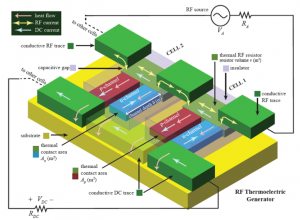 Despite recent gains in turn-on sensitivity, passive RFID tags are approaching fundamental limits imposed by diode conversion of RF-to-DC power. However, an RF-to-thermal-to-DC energy conversion process can be shown to outperform existing diode conversion techniques at very low power levels. We explore the original design of an RF-driven thermoelectric generator and demonstrate a possible pathway to a purely passive tag with greater than 100m range.
Despite recent gains in turn-on sensitivity, passive RFID tags are approaching fundamental limits imposed by diode conversion of RF-to-DC power. However, an RF-to-thermal-to-DC energy conversion process can be shown to outperform existing diode conversion techniques at very low power levels. We explore the original design of an RF-driven thermoelectric generator and demonstrate a possible pathway to a purely passive tag with greater than 100m range.
uMonitor: In-situ Energy Monitoring with Microwatt Power Consumption
Saman Naderiparizi, Aaron N Parks, Farshid Salemi Parizi and Joshua R. Smith (University of Washington, USA)
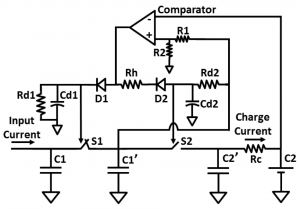 Knowledge of energy flow in a microwatt-class energy harvesting system is essential to reliable deployment and scheduling of sensing, computation, communication, and actuation tasks. However, existing techniques for monitoring energy flow fail to meet the basic requirements for in-situ realtime monitoring systems by failing to be efficient and failing to perform accurately across a wide dynamic range. The proposed system, uMonitor, makes use of a highly power-optimized “Coulomb counting” implementation to achieve less than 1.7 microampere current draw, 94% efficiency in-situ, and high energy flow measurement accuracy across four orders of magnitude.
Knowledge of energy flow in a microwatt-class energy harvesting system is essential to reliable deployment and scheduling of sensing, computation, communication, and actuation tasks. However, existing techniques for monitoring energy flow fail to meet the basic requirements for in-situ realtime monitoring systems by failing to be efficient and failing to perform accurately across a wide dynamic range. The proposed system, uMonitor, makes use of a highly power-optimized “Coulomb counting” implementation to achieve less than 1.7 microampere current draw, 94% efficiency in-situ, and high energy flow measurement accuracy across four orders of magnitude.


